Ensuring Safe Patient Transport on Stairs
A stair stretcher is a specialized medical transport device designed specifically for moving patients up and down stairs safely and efficiently. For those needing quick information:
| Stair Stretcher Quick Facts | |
|---|---|
| Primary Purpose | Safe patient transport on staircases |
| Weight Capacity | 350-500 lbs |
| Average Weight | 20-31 lbs |
| Key Features | 2-3 patient restraint straps, foldable design, non-slip handles |
| Types Available | Manual, tracked, electric, chair-style |
| Primary Users | EMS, firefighters, hospitals, home healthcare providers |
Stair stretchers address a critical safety need in medical transport and evacuation scenarios. With over 1 million stair-related injuries occurring annually in the US and approximately 50% of American homes containing staircases, these specialized devices help prevent further injury during patient transport while protecting the safety of medical personnel.
Unlike traditional stretchers, stair stretchers are specifically engineered with features like tracked systems, specialized handles, and compact folding mechanisms that make navigating narrow stairwells possible without compromising patient security or operator safety.
I'm Mortuary Cooler, a national-level supplier of specialized medical transport equipment including stair stretchers, with extensive experience helping emergency services and healthcare facilities select the right stair stretcher solutions for their specific operational needs. My work with various EMS departments has provided valuable insights into the practical aspects of stair stretcher deployment in emergency situations.

Must-know stair stretcher terms:
Why Safe Stair Transport Matters
The importance of safe stair transport cannot be overstated. With the annual cost of non-fatal stair injuries in the US averaging $92 billion, proper equipment and protocols are essential. Confined stairwells present unique challenges during patient transport, including:
- Limited space for maneuvering traditional stretchers
- Increased risk of falls for both patients and operators
- Difficulty maintaining proper body mechanics while carrying patients
- Potential for secondary injuries during emergency evacuations
In emergency situations, every second counts. Having the right equipment not only improves patient outcomes but also protects the health and safety of medical personnel. As specialists in medical transport equipment at American Mortuary Coolers, we've seen how proper stair stretchers can make the difference between a smooth transport and a dangerous situation.
What Is a Stair Stretcher & When Is It Used?
A stair stretcher is your lifeline when faced with the challenge of moving patients up and down stairs. Think of it as the superhero version of a regular stretcher – specifically designed to conquer staircases and uneven terrain while keeping both patients and operators safe.
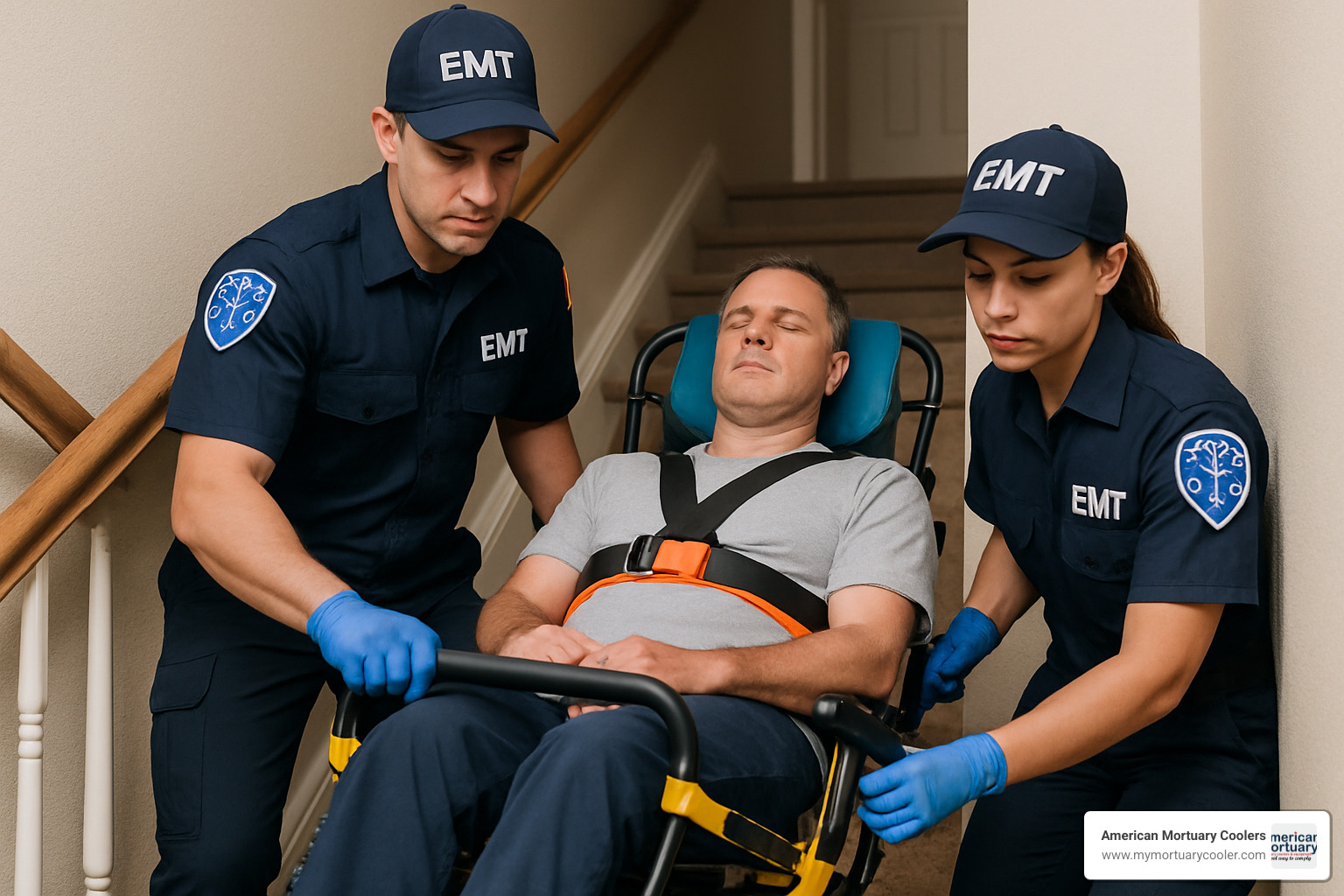
I've spoken with countless EMS teams who tell me these devices are absolute game-changers in their daily work. As one Dallas paramedic put it, "When seconds count and we're faced with three flights of stairs, our stair stretcher means we don't have to choose between speed and safety."
These specialized transport devices shine in multiple scenarios – from emergency evacuations during disasters to routine patient transfers in home healthcare. They're equally valuable for EMS teams rushing to medical emergencies in apartment buildings and for funeral homes providing dignified transport services when elevators aren't an option.
Core Differences From Traditional Stretchers
What makes a stair stretcher special isn't just a few tweaks to a regular design – these are purpose-built transport solutions with fundamental differences:
The most obvious feature you'll notice is the track system many models employ – those continuous treads or belts that grip stair edges and control descent. Unlike a traditional stretcher's flat bottom, these tracks transform staircases from obstacles into manageable pathways.
The handles are positioned at different heights and angles, acknowledging the reality that carrying someone down stairs requires a completely different body position than moving across flat ground. This ergonomic design protects operators' backs while improving patient stability.
Most stair stretchers also fold down to remarkably compact sizes. When I visit ambulance stations, crews often show me how they store these devices in spaces I wouldn't believe possible – a crucial feature when every inch of vehicle space matters.
The restraint systems deserve special mention too. They're engineered to secure patients at the angles encountered on stairs, preventing sliding and maintaining proper position even during steep descents.
Common Use-Case Scenarios
Real-world applications for stair stretchers are remarkably diverse:
During fire evacuations, these devices become critical when elevators are shut down. I've heard from Chicago fire department personnel who credit their stair stretchers with saving lives during high-rise emergencies.
In historic buildings without elevator access – from Brooklyn brownstones to San Francisco Victorians – healthcare providers rely on these devices daily. Home health agencies serving older communities often consider stair stretchers essential equipment.
For bariatric patients, specialized models can safely manage weights up to 500 pounds, providing dignity and safety that might otherwise be impossible on staircases.
Rehabilitation clinics incorporate these devices into their programs, both for emergency preparedness and as part of stair navigation training for recovering patients.
Medical teams at concert venues, sports stadiums, and convention centers with multiple levels keep stair stretchers on hand for quick response when elevators are congested or unavailable.
An Atlanta paramedic shared a particularly moving story with me: "We got called to help an elderly woman experiencing chest pain in her third-floor apartment. The building's elevator was out of service – again. Without our stair stretcher, we would have faced an impossible choice between risking her safety or waiting precious minutes for additional help. Instead, we had her safely in the ambulance within minutes. That's why we never leave the station without it."
Main Types of Stair Stretchers & How They Work
Let's talk about the different kinds of stair stretchers you might encounter. Each type has its own special features that make it shine in different situations - kind of like having the right tool for the job!
Manual Stair Stretcher Basics
Manual stair stretchers are the workhorses of the industry - simple, reliable, and ready when you need them. Think of them as the trusty pickup truck in your equipment garage.
These stretchers feature multiple strategically placed handles that give operators the leverage they need to safely move patients up and down stairs. They typically weigh between 20-25 pounds, making them light enough to carry but sturdy enough to trust with precious cargo.
What makes manual models special is their simplicity. With no batteries to charge or electronics to fail, they're always ready for action. Our emergency responder friends in Tennessee tell us, "Manual stair stretchers are our go-to for quick response situations. Their simplicity means less can go wrong, and they're ready when seconds count."
They're perfect for organizations watching their budget, situations where you need to move quickly, and buildings where you only occasionally need to transport patients via stairs. The trade-off? They do require more physical strength from the operators - typically at least two people working together.
Powered Stair Stretcher Advantages
Now, if manual stretchers are pickup trucks, powered stair stretchers are like luxury SUVs with all the bells and whistles. These technological marvels take much of the physical strain off your team.
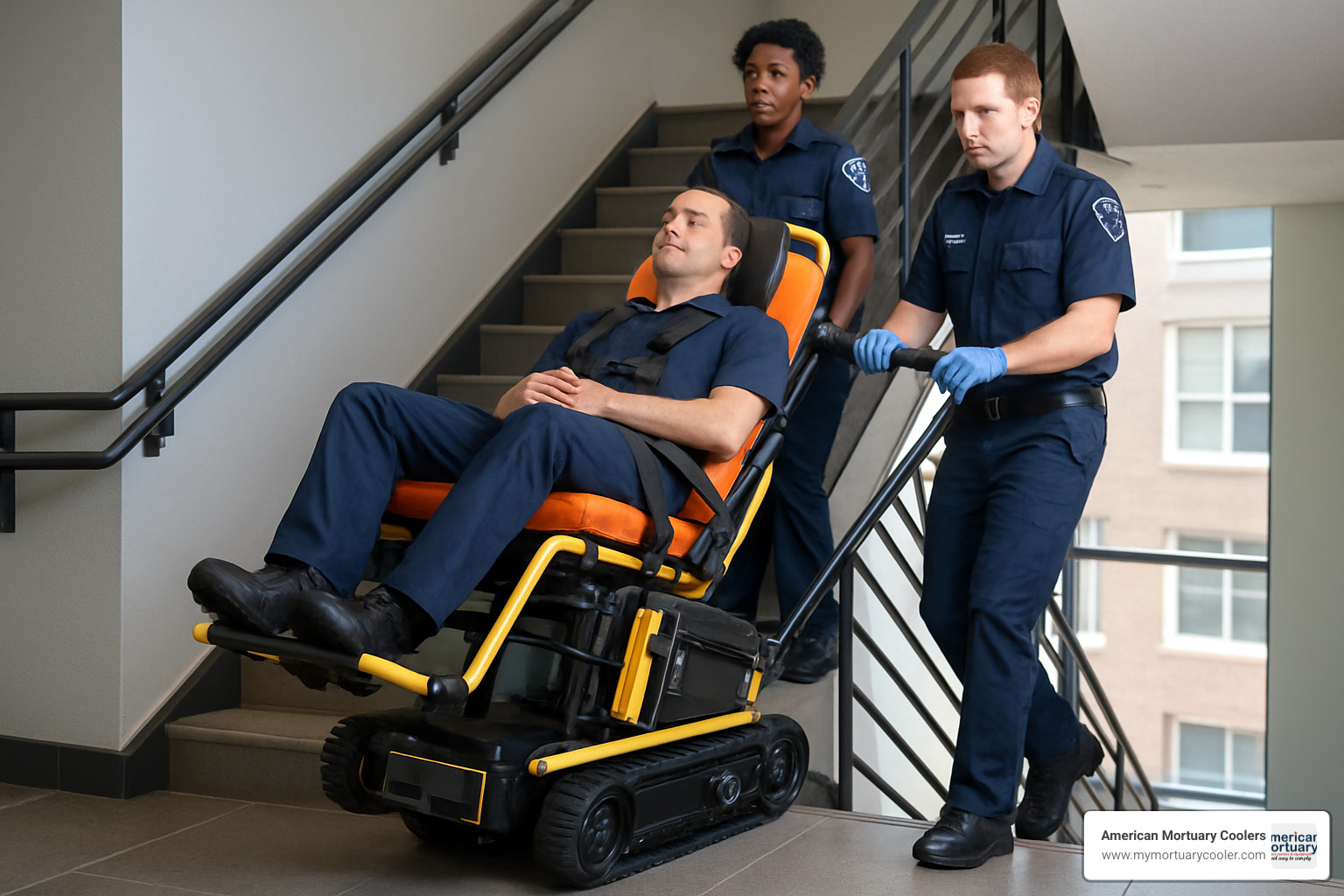
Powered models use electric motors connected to tracks or belts that grip stair edges, creating a smooth, controlled movement that feels almost like gliding. The rechargeable battery systems power everything, while simple controls (often just a joystick or a few buttons) let operators guide the stretcher with minimal effort.
The beauty of these systems is how they reduce the physical burden on your team. Many can handle patients weighing up to 500 pounds, which would be extremely challenging with manual models. This means fewer back injuries and longer careers for your staff - something we care deeply about at American Mortuary Coolers.
These shine brightest in facilities that frequently transport patients on stairs, when handling bariatric patients, or when you're working with limited staff. Yes, they cost more upfront, but many of our customers find the investment pays for itself in reduced worker compensation claims alone.
Want to dive deeper into the powered options? Check out our A Comprehensive Guide to Finding the Best Power Stair Chair for more details.
Tracked & Hybrid Models Explained
Tracked and hybrid stair stretchers offer that sweet middle ground - more help than manual models without the full price tag of powered versions. Think of them as the crossover vehicles of the stair stretcher world.
These clever designs use continuous belt or track systems that grip stair edges, creating controlled resistance during descent. The tracks do the hard work of gripping and stabilizing, while operators guide rather than fully support the weight. Many models include automatic braking systems that engage if the operators let go - an important safety feature when you're responsible for someone's well-being.
What makes these models special is their versatility. Beyond just stairs, many can handle uneven terrain like gravel paths or thresholds. Some hybrid models even incorporate limited power assistance while maintaining the reliability of manual systems.
A funeral director from our Columbia, SC location shared with us, "Tracked systems give us the best of both worlds. They're more affordable than fully powered units but still provide significant assistance when navigating difficult staircases with dignity."
These models are particularly valuable when you need equipment that can handle varied environments, when you're looking for that balance between budget constraints and staff safety, or when different transport scenarios require adaptable equipment.
At American Mortuary Coolers, we've helped countless customers find the right stair stretcher for their specific needs - whether that's a simple manual model or a high-tech powered system. After all, the right equipment doesn't just make the job easier - it keeps everyone safer.
Features, Materials, Safety & Specs That Matter
Shopping for a stair stretcher can feel overwhelming with all the options available. Let's break down what really matters so you can make the best choice for your specific needs.
Quality stair stretchers typically feature lightweight aluminum alloy frames that provide the perfect balance of strength and portability. You'll find that good models include ABS plastic seats that not only resist bodily fluids but also make cleanup between patients quick and straightforward. Those non-slip rubber grips on the handles aren't just for comfort—they're essential safety features when operators are navigating tricky staircases while supporting a patient's weight.
"I learned the hard way that hardware quality matters," shares one of our long-time customers from Nashville. "Our first budget stair stretcher started showing corrosion after just six months of use. The medical-grade webbing on better models is worth every penny when you're securing patients day after day."
How Stair Stretchers Improve Patient & Operator Safety
The thoughtful design of modern stair stretchers addresses safety from multiple angles. Ergonomically positioned handles help operators maintain proper body mechanics, significantly reducing back strain during patient transport. The weight distribution systems are engineered to minimize pressure points—both for the patient being carried and the professionals doing the carrying.
Head support features are particularly important when moving patients on inclines. Good stair stretchers include specialized supports that prevent head movement, which is crucial for patients with potential neck injuries. Most quality models feature 2-3 patient restraint straps with quick-release buckles that secure patients firmly while allowing rapid release if needed.
Those textured, non-slip surfaces aren't just a nice-to-have feature—they prevent potentially dangerous patient sliding during transit. And don't overlook the importance of solid locking mechanisms that keep the stretcher securely deployed throughout the transport process.
"Since switching to proper stair stretchers with all these safety features, our workplace injury reports have dropped by nearly 40%," notes our operations manager. "That's not just good for our team's health—it's good business sense too."
Certifications & Standards to Check
Before finalizing your purchase, take a moment to verify your chosen stair stretcher meets relevant safety standards:
- FDA Registration ensures basic medical device requirements are met
- CE Marking indicates compliance with European health and safety standards
- ISO 9001 certification means the manufacturer follows recognized quality management systems
- EN1865 specifically addresses ambulance stretcher requirements
- ASTM F2020 covers powered patient transport equipment in the American market
"I've been in this business for over 20 years," shares our quality control specialist at American Mortuary Coolers, "and I've never seen a situation where cutting corners on certifications ended well. These standards exist for good reason."
When comparing different models, this handy specifications chart might help you narrow down your options:
| Specification | Typical Range | Why It Matters |
|---|---|---|
| Weight Capacity | 350-500 lbs | Must accommodate your patient population |
| Unit Weight | 20-45 lbs | Affects portability and operator fatigue |
| Folded Dimensions | 35"×7"×23" to 42"×21"×15" | Determines storage requirements |
| Deployed Dimensions | 25"×20"×36" to 51"×19"×61" | Affects maneuverability in tight spaces |
| Track Width | 14-22 inches | Must fit your typical staircase width |
| Battery Life (powered) | 20-40 transports | Determines operational readiness |
Remember to measure your storage space before ordering. We've had more than one customer call us in a panic because their new stair stretcher wouldn't fit in their designated cabinet or ambulance compartment. A little preparation goes a long way toward avoiding these frustrating situations.
The right stair stretcher balances durability, safety features, and practical specifications for your specific needs. Don't hesitate to reach out to our team if you have questions about which model might work best for your particular situation.
Buying Guide: 10 Factors, Brands, Costs & Considerations
Selecting the right stair stretcher requires careful consideration of numerous factors. Here's a comprehensive guide to help you make an informed decision.
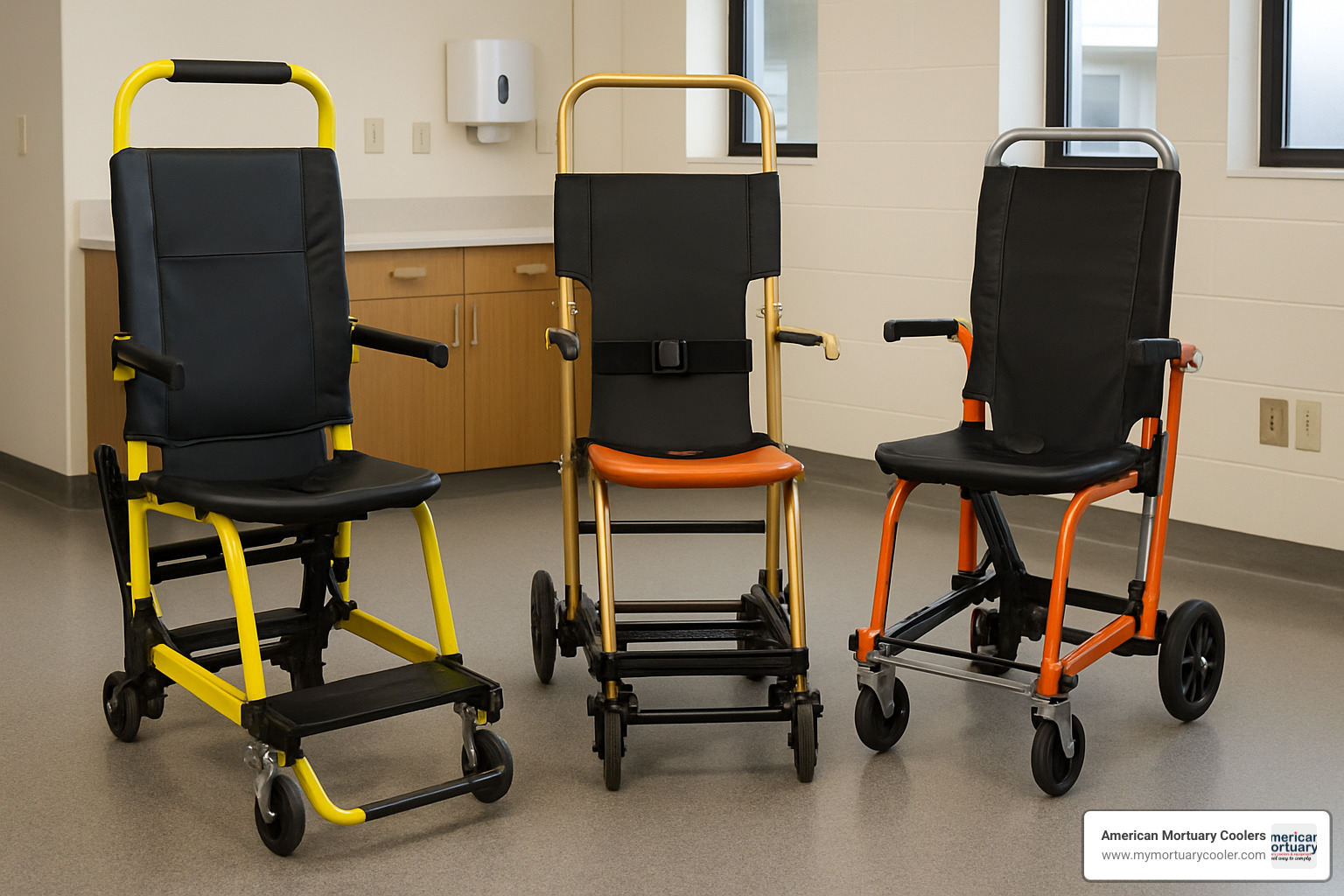
10 Critical Factors to Consider
When we work with emergency services and healthcare providers, they often ask us what matters most in choosing a stair stretcher. First and foremost, consider the weight capacity – you'll need a model that safely handles your heaviest anticipated patients. The stretcher's dimensions matter too, both when deployed and folded, especially if you're working in tight spaces like older buildings or narrow stairwells.
The terrain compatibility is something many buyers overlook until it's too late. Those perfectly smooth stairs in the product demo? They're nothing like the worn, carpeted steps you might encounter in real-world situations. Think about your operator requirements too – some models need two people minimum, while others can be managed by a single operator in a pinch.
"Budget is always important, but I tell my clients to think about the long game," says Mark, our emergency services specialist. "A $2,000 investment spread over 10 years of daily use is actually quite reasonable when you consider the safety benefits."
Your warranty coverage should be comprehensive – look for at least 3-5 years on frame components. Consider what accessories you might need, from head immobilizers to wall-mounted storage solutions. The training support provided can make or break your team's ability to use the equipment effectively, so ask about training videos, in-person sessions, or online resources.
Don't forget about maintenance requirements – some powered models need regular servicing that adds to the lifetime cost. Finally, ensure compatibility with your existing equipment and protocols, particularly if you're integrating with ambulance mounting systems.
Leading Brands in the Market
In our years serving emergency services across the country, we've seen certain brands consistently deliver quality and reliability. MOBI Medical has earned a reputation for lightweight, durable designs that fold down impressively small. Their attention to detail on grip surfaces is particularly noteworthy.
Evac+Chair specializes exclusively in evacuation equipment, and their focus shows in the thoughtful design of their products. Stryker remains the industry heavyweight, offering comprehensive solutions that often integrate with their other emergency equipment. While their products command premium prices, many departments swear by their reliability.
Ferno brings decades of experience to their designs, with a particularly strong track record in durability. For those looking for something a bit different, Spencer offers European-engineered alternatives with some innovative approaches to stair descent mechanics.
For specialized situations or temporary needs, rental options like those from Stair Climber Hire - Specialist Lifting Solutions might make sense, especially for facilities managing temporary construction or elevator outages.
Cost Comparison: Stair Stretcher Options
Let's talk money – what should you expect to pay for a quality stair stretcher? Basic manual models typically run $800-$1,500. They're simple to maintain with no batteries to worry about, making them popular with volunteer services and smaller departments.
Tracked manual models fall in the $1,500-$3,000 range. The tracks add significant mechanical advantage but also introduce more moving parts that need occasional maintenance. Basic powered models start around $3,000 and can reach $5,000, bringing battery management into the equation – you'll need charging stations and protocols for ensuring power is available when needed.
Advanced powered models can range from $5,000 to over $12,000 for systems that integrate with vehicle mounting solutions. These high-end options often include software updates and require more specialized training.
"When calculating ROI, many departments forget to factor in potential savings from reduced worker injuries," explains Jennifer from our accounting team. "One back injury can cost tens of thousands in workers' comp and lost time – suddenly that powered model looks like a bargain."
Beyond the sticker price, budget for annual maintenance (typically 3-5% of purchase price), operator training, and replacement parts. Most quality stair stretchers will serve 7-10 years with proper care, making them a long-term investment in your team's safety.
Notable Models Worth Considering
After helping hundreds of clients find their ideal equipment, we've identified several standout models. The MOBI 5C PRO Stair Stretcher offers professional-grade quality with a 450+ lb capacity, thoughtfully designed non-slip handles, and durable ABS seating. It's become our most recommended model for departments seeking reliability without the complexity of power assistance.
The Evac Chair 300 Series wins points for its remarkably light 31 lb weight while still supporting up to 350 lbs. Its three-piece restraint system and intuitive folding design make it particularly popular with facilities that need occasional rather than daily use.
For departments with adequate budget who prioritize operator safety above all else, the Stryker Power-LOAD represents the gold standard. Its integration with vehicle mounting systems creates a seamless transfer process from stairs to ambulance.
"We switched to the MOBI 5C PRO last year after burning through cheaper models," shared a paramedic from Nashville. "The difference in build quality was immediately noticeable – especially in the handle grips and wheel durability."
Considerations for Mobility Challenges
Not every situation calls for a full stair stretcher. For patients with partial mobility or those needing regular stair access at home, consider alternatives like stair walkers. Products like the AssiStep provide support for individuals who can partially steer stairs but need additional stability.
Cane rails offer specialized handrails with improved grip surfaces that can make a dramatic difference for those with moderate mobility challenges. Various supportive aids combine features of traditional walkers with stair-specific adaptations for daily use.
"We often recommend a combination approach for home healthcare," says Tammy, our mobility specialist. "A stair walker for daily use by partially mobile patients, with a folding stair stretcher stored nearby for emergency situations."
These alternatives can provide greater independence while maintaining safety, particularly for long-term home use situations. For more information on transport options focused on patient comfort, check out Ensuring Comfort and Safety with Stretcher Transportation.
Maintenance, Training & Real-World Insights
Let's face it - even the best stair stretcher in the world won't help much if it's broken when you need it most. That's why proper care and training aren't just good ideas - they're absolutely essential.
Maintenance Procedures
Keeping your stair stretcher in top shape isn't complicated, but it does require consistency. After each use, give it a thorough cleaning with appropriate disinfectants - this protects both your team and future patients. For parts that come into direct contact with patients, follow the manufacturer's sterilization guidelines.
"I've seen perfectly good equipment fail simply because nobody bothered to check it regularly," our equipment specialist often tells clients. "A simple maintenance log can save lives."
Set up a regular inspection schedule - weekly visual checks and monthly mechanical inspections catch small issues before they become dangerous problems. Don't forget about lubrication! Those moving parts need manufacturer-recommended lubricants to operate smoothly.
For powered models, battery care makes all the difference. Follow charging protocols carefully to maximize battery life, and regularly inspect tracks and belts for signs of wear, proper tension, and alignment.
Proper Storage & Routine Checks
Where and how you store your stair stretcher directly impacts its readiness in an emergency. Ideally, keep it in a dedicated wall-mounted cabinet designed specifically for your model. Always store it in the manufacturer-recommended folded position to prevent warping or damage.
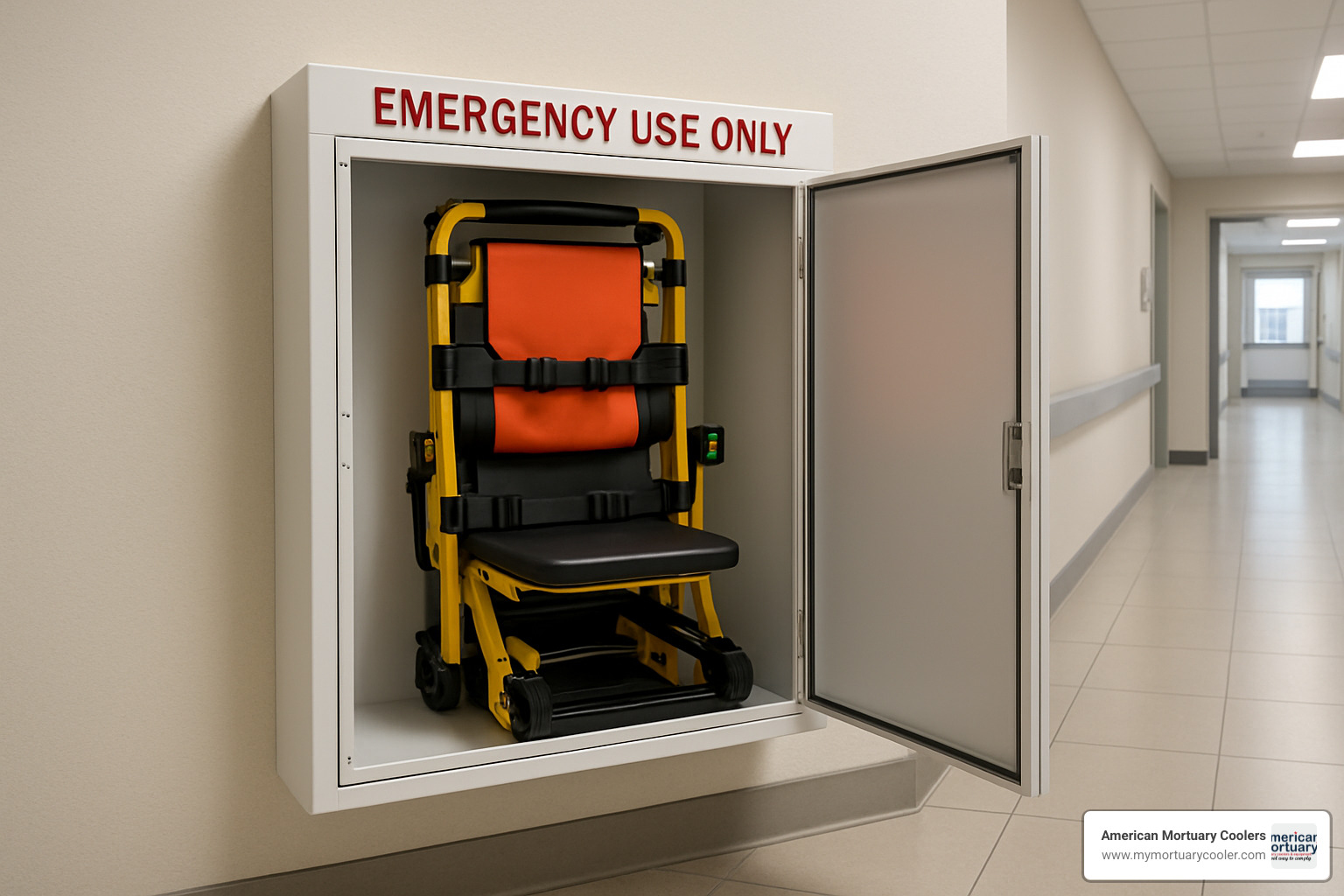
For powered models, maintain proper battery charge levels - a dead battery during an emergency evacuation creates a dangerous situation. Regularly examine restraint straps for fraying or damage, and check that buckles function properly.
"We recommend monthly deployment drills that include retrieving the stretcher from storage," says our training coordinator. "This ensures the storage system works and the team knows exactly how to access it quickly."
Store your stair stretcher in an easily accessible location, away from extreme temperatures and moisture which can degrade materials over time.
Training Requirements for Safe Use of a Stair Stretcher
There's an old saying in emergency services: "You don't rise to the occasion in an emergency; you fall to your level of training." This couldn't be more true when it comes to stair stretcher operation.
Start with formal certification on your specific model. Every stair stretcher has unique features and safety mechanisms that operators must understand thoroughly. Regular two-person drills practicing coordinated movements and clear commands build the teamwork essential for safe patient transport.
Don't just practice on one type of staircase. Train on various stair configurations and angles to prepare for real-world scenarios. Develop and practice emergency protocols for handling equipment failures or complications during transport.
"Training should never be a one-time event," emphasizes our Los Angeles training coordinator. "Regular practice with realistic scenarios is essential for maintaining proficiency."
Proper weight distribution techniques are crucial for maintaining balance on stairs, so make this a focus of your training program. Schedule quarterly skill reviews and always document all training sessions and certifications for compliance and liability purposes.
Real-World Insights and Case Studies
Sometimes the best way to understand the value of proper stair stretcher selection and training is through real examples.
A Los Angeles EMS team responded to a medical emergency in a fourth-floor apartment with no elevator access. The patient weighed approximately 280 pounds and was experiencing severe respiratory distress. Using their tracked stair stretcher, the team safely transported the patient down a narrow stairwell in under four minutes - potentially saving the patient's life by enabling rapid transport to definitive care.
"The tracked system made what would have been an extremely difficult carry manageable for our two-person team," reported the responding paramedic. "Without it, we would have needed to call for additional resources, delaying transport significantly."
At American Mortuary Coolers, we've seen how proper equipment selection and training transform difficult situations into manageable ones. Our team in Tennessee works with emergency services nationwide to ensure they have the right tools and knowledge for safe patient transport.
For additional perspectives on ensuring patient dignity and safety during transport, take a look at Ensuring Comfort and Safety with Stretcher Transportation.
Frequently Asked Questions about Stair Stretchers
What is the typical weight capacity of a stair stretcher?
Most stair stretchers can safely carry between 350 and 500 pounds, though this varies by model. The manual versions typically handle lower weights (around 350-400 pounds), while their powered cousins can often manage up to 500 pounds.
When we work with emergency services departments across the country, we always remind them to choose a model that exceeds their expected needs. Operating a stretcher near its maximum capacity isn't just harder on the equipment—it puts extra strain on the people operating it too.
"I always tell our clients to think about who they'll actually be transporting," says our Tennessee-based product specialist. "Look at your community demographics, consider whether you serve bariatric patients, and don't forget to factor in any medical equipment that might be attached to the patient. A good rule of thumb is to stay below 80% of the maximum capacity whenever possible—your equipment will last longer, and your team's backs will thank you!"
Do powered stair stretchers need special maintenance?
Yes, powered stair stretchers definitely require more TLC than manual models. Think of them like any other piece of sophisticated equipment—more features mean more maintenance.
Battery management is probably the biggest difference. You'll need to follow proper charging cycles and typically replace batteries every 2-3 years. The motors and electronic control systems need regular inspection, and the tracks or belts require proper tension checks. Some of the newer models with digital controls even need software updates—something you'd never worry about with a manual stretcher!
Most manufacturers recommend professional servicing every 6-12 months, in addition to your team's regular cleaning and inspection after each use.
"One of my Pittsburgh clients learned this lesson the hard way," our maintenance specialist shares with a knowing smile. "They skipped maintenance to save money, only to have their powered stretcher fail during a critical transport. The emergency repair and downtime cost them far more than regular maintenance would have. Now they're our most diligent maintenance customers!"
Are stair stretchers suitable for bariatric patients?
Stair stretchers can absolutely work for bariatric patients—but you need the right equipment and approach. This is something we help many clients steer at American Mortuary Coolers.
For patients over 350 pounds, we strongly recommend powered models to reduce the physical strain on your team. Look specifically for stretchers rated for bariatric use (usually 450+ pound capacity) with wider tracks or bases for better stability. These models typically feature reinforced frames and more robust restraint systems designed specifically for larger patients.
Even with the best equipment, though, bariatric transport often requires additional personnel. The safety of everyone involved depends on having enough hands on deck.
"There's a delicate balance when transporting bariatric patients," explains our Midwest regional specialist. "You need to maintain the patient's dignity and comfort while ensuring your team doesn't get injured. I've seen departments transform their bariatric transport capabilities just by investing in the right stair stretcher and proper training."
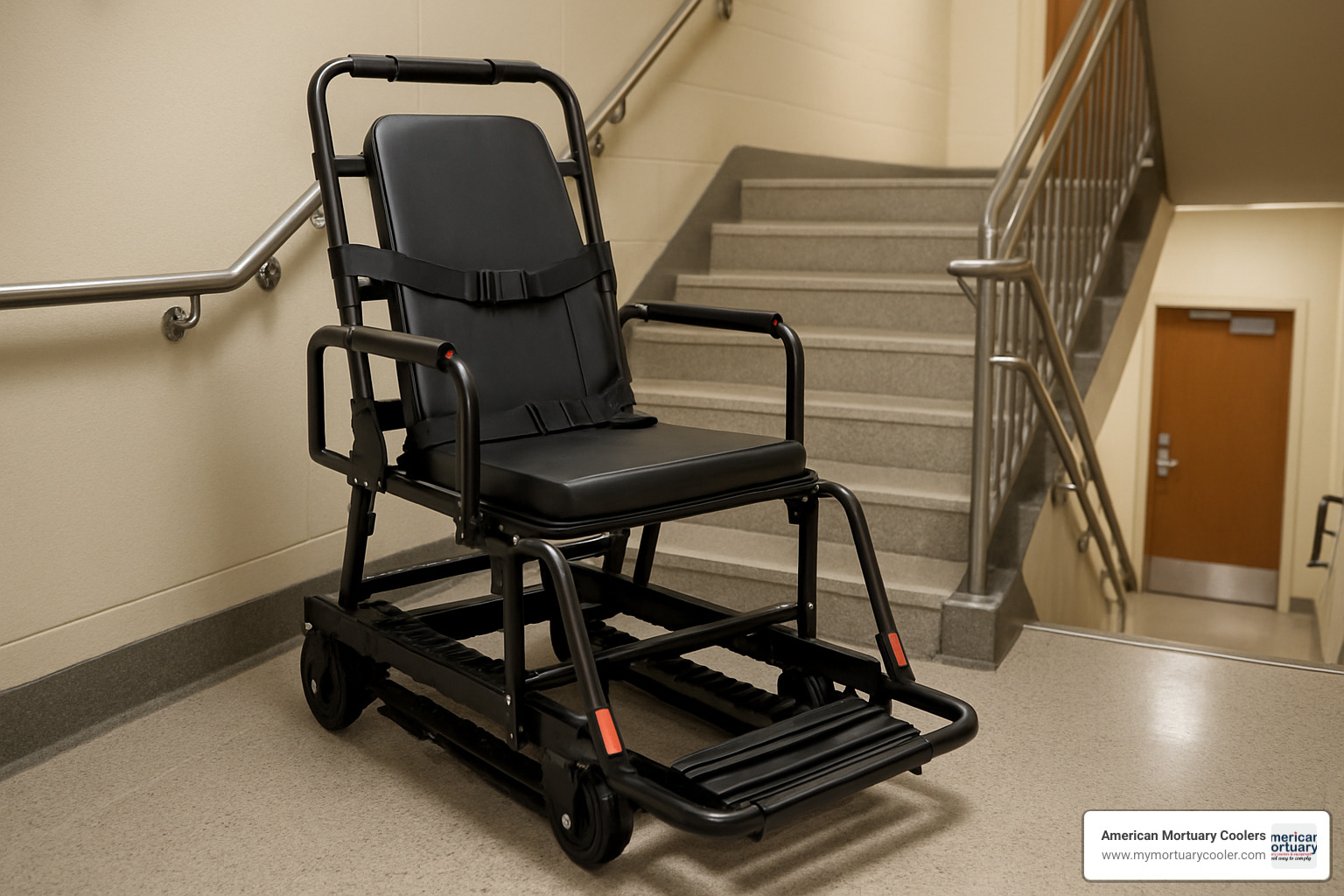
Conclusion
Choosing the right stair stretcher isn't just about buying equipment—it's about making a decision that directly impacts lives. Throughout this guide, we've walked through the various options available and what matters most when making this important choice.
When it all comes down to it, safety should always be your North Star. The best stair stretcher for your organization protects both your patients and your team members from injury during those challenging stair transports. I've seen how the right equipment prevents back injuries and patient falls that can have life-altering consequences.
Your specific needs should guide your selection process. A busy urban EMS service faces different challenges than a rural home healthcare provider or a funeral home. Be honest about your typical scenarios—how many flights of stairs do you usually steer? What's the average weight of your patients? How many staff members are typically available? The answers will point you toward your ideal solution.
While that initial price tag might make you wince, remember to think long-term. A quality stair stretcher that lasts for years and prevents even one workplace injury has already paid for itself. Factor in maintenance costs, training requirements, and expected lifespan when calculating the true value of your investment.
Speaking of training—don't skimp here! Even the most advanced stair stretcher becomes dangerous in untrained hands. Ensure everyone who might use the equipment receives proper instruction and regular practice opportunities. Those quarterly drills might seem tedious, but they build the muscle memory that makes all the difference during high-stress situations.
Establish a regular maintenance schedule and stick to it religiously. A well-maintained stair stretcher works reliably when you need it most, while neglected equipment fails at the worst possible moments. Those monthly checks take just minutes but can prevent catastrophic failures.
At American Mortuary Coolers, we've helped countless organizations across Tennessee, Georgia, Illinois, South Carolina, Texas, California, New York, and Pennsylvania find their perfect stair stretcher solution. We understand that different facilities have unique requirements, and we're always happy to share our expertise to help you make the best choice for your specific situation.
If you're in the process of evaluating other specialized equipment for your facility, you might find our article on Selecting the Right Refrigeration Equipment for Your Business helpful as well.
Investing in the right stair stretcher isn't just about checking a box for compliance—it's about showing care for your team members and the people you serve. By thoughtfully considering the factors we've discussed, you're taking an important step toward safer operations and better outcomes for everyone involved.
















